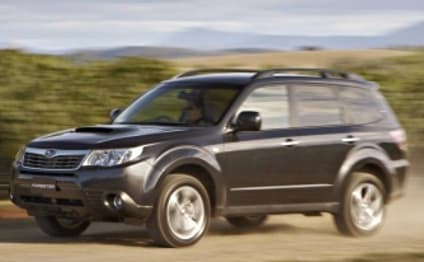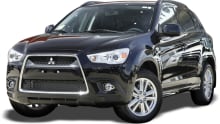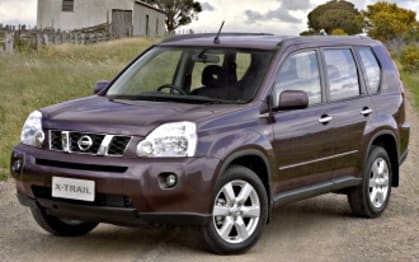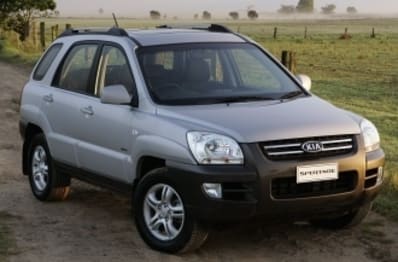
Used Subaru Forester review: 2008-2013
- Subaru Forester
- Subaru Forester 2008
- Subaru Forester 2009
- Subaru Forester 2010
- Subaru Forester 2011
- Subaru Forester 2012
- Subaru Forester 2013
- Subaru Forester Reviews
- Subaru Reviews
- Subaru SUV Range
- SUV
- Subaru
- Used Car Reviews
- Off road
- Takata
- Recalls
- Family Cars
What we like
- ISOFIX mounting points
- Turbocharged 2.5-litre engine
- 5 star ANCAP score
What we don't
- No park assist
- Affected by Takata airbag recall
- Transmission troubles
What we like
- ISOFIX mounting points
- Turbocharged 2.5-litre engine
- 5 star ANCAP score
What we don't
- No park assist
- Affected by Takata airbag recall
- Transmission troubles
The Forester has been one of the most popular and highly rated SUVs on the market since it was launched in 1997.
Subaru’s main challenge has been keeping it at the front of the pack in a hotly contested market segment that’s been getting hotter and hotter with new makers and fresh models arriving almost by the day.
It was into that cauldron of hot competition that Subaru launched a new, much updated S3 model in 2008.
Models
After the Forester was criticised for being too cramped for families Subaru hit back in 2008 with the S3.
It followed the familiar Subaru theme of all-wheel drive and a boxer engine, but it was also longer, wider, taller, and sat on a longer wheelbase.
With all of that the cabin was roomier and more comfortable, and the boot was larger.
It was also refreshed with new looks. Gone were the squarer, boxy lines, the new model was smoother and more attractive.
The X continued to be the entry model; its list of standard features consisted of dual front airbags, side front airbags, abs anti-lock braking, electronic brakeforce distribution, traction control, electronic stability control, air conditioning, cruise control, remote central locking, four-speaker sound, CD player, power windows and mirrors, and roof racks.
For more there was the XS, which added air conditioning with climate control, 16-inch alloy wheels, seven-speaker sound, a CD stacker, front fog lamps, rear spoiler, and self-levelling suspension.

If that wasn’t enough there was the XS Premium, which added 17-inch alloy wheels, leather trim, a leather-trimmed steering wheel, and a power sunroof to the list.
For a drive with a little more zip there was the turbocharged XT, which was similarly equipped to the XS, but with 17-inch alloy wheels and Xenon headlights.
On top of that the XT Premium had leather trim, a leather steering wheel, and a power sunroof.
An update in 2009 saw emergency brake assist, head airbags, and a trip computer added across the range, and the XS was upgraded to 17-inch alloy wheels.
With the call for diesel engines growing ever louder Subaru responded with the diesel-powered 2.0D and 2.0D Premium in 2010.
An update in 2011 brought Bluetooth to allow the connection of an iPhone or Android device, a DVD player, and a reversing camera, but there were no parking sensors, park assist system, or touch screen, and sat nav was an option.
The spare tyre was a full-sized one.
Cabin
Being 75mm longer, 60mm wider and 110mm taller, and 90mm longer in the wheelbase, the S3 Forester was much roomier.
There was more head, elbow, and legroom, and the boot space grew by 15 per cent to 450 litres when the split-fold rear seat was in the upright position.

Cupholders were provided for those in the front and rear.
Lap/sash seat belts in all five seats allowed the fitment of a baby car seat.
The S3 Forester has ISOFIX mounting points, even though they weren’t mandatory in Australia until 2014.
Engine
A 2.5-litre horizontally opposed 'flat' four cylinder petrol engine powered most models in the range.
It carried over from the previous model, with peak power at 126kW (169 horsepower), but with marginally more torque at a maximum of 229Nm.
The maximum torque was raised to 235Nm in 2011, but there was no extra horsepower.
The 2.5-litre turbocharged four-cylinder continued to be the hero motor, producing 169kW and 320Nm at launch of the S3.
It required 95-octane premium unleaded, but when working at its peak would do the 0-100km/h dash in 7.9 seconds.

Arguably the major change in the S3 model was the arrival of a diesel engine, a move that was prompted by a growing demand from buyers looking to save money at the gas pump.
The engine was 2.0-litre four-cylinder horizontally opposed boxer motor, which when pressed to the limit produced 108kW and 350Nm.
Sadly for those eagerly awaiting the arrival of the diesel it was only available with a six-speed manual gearbox.
The turbo-diesel engine was the hero motor when it came to fuel consumption. Its combined average of 6.0L/100 km put it well ahead of the 2.5-litre petrol engine with its average of 9.3-9.6L/100 km.
Transmission choices were a five-speed manual gearbox and a four-speed automatic transmission, the latter with sports shifting. The only exception was the diesel, which was only available with a six-speed manual gearbox.
Like all Subarus the final drive was dual-range with a limited-slip centre diff directing drive through all four wheels for safety and stability.
Driving
Just about all carmakers will tell you their SUVs drive just like a regular car, but of them all the Forester is one of the best.
With its independent front and independent rear suspension it rides and handles as you would expect a car to.
It rides comfortably over most surfaces, and the handling is assured, as it should be with all-wheel drive.
Inside it’s comfortable and refined, there is little wind or road noise to bother you.

Once you leave the blacktop the Forester continues to thrive, at least until you get to the more extreme going when ground clearance becomes an issue.
With its dual-range drive system the Forester can cope well with rough and rutted tracks, and is at home on a beach, but don’t attempt to climb rocks and boulders or you’ll risk getting stranded.
The performance of the 2.5-litre engine is solid, and the gearing is well matched to the engine’s torque curve, ensuring the driveability is smooth.
Step up to the turbocharged 2.5-litre engine and the performance goes ballistic.
At the other end of the spectrum is the turbo-diesel, which is biased towards driveability with its torque, and of course fuel economy, which is admirable.
Safety
The S3 Forester entered the fray with a full five-star tick of approval from ANCAP.

Right from the start it had dual front, head and side airbags, and seat belt pretensioners for a comprehensive array of passive safety features.
But it also had a full complement of active safety features in the form of ABS anti-lock braking, electronic brakeforce distribution, emergency brake assistance, traction control and electronic stability control.
Any common issues?
Reliability of the S3 Forester is generally good with few problems reported by mechanics or owners.
The engine is robust and reliable as long as it is fed a regular diet of clean, fresh 5W-40 oil every 12,500 km or six months and the cam timing belt is replaced every 100,000km.
They generally burn little oil, but can sometimes issue a puff of smoke on start-up from cold. They’re more prone to oil leaks, so check around the engine bay.
Likewise the transmissions give little trouble, but be prepared to replace the clutch every 100,000km or so on the manual gearbox.
The S3 is affected by the Takata airbag recall, so check that it has been done, or is scheduled to be.
Damage caused by off-road use is to be anticipated, so carefully inspect cars from top to bottom looking for bumps and scrapes from too close encounters with the landscape.
Check for a service record to confirm your proposed purchase has been properly maintained.
Subaru introduced lifetime capped price servicing in 2104; the cover is applicable to all models back to 2006, which includes the S3.
If you choose not to use a Subaru dealer to service your car it can be done by any mechanic, and the service cost isn’t excessive.
The new car warranty applicable to the S3 covered the car for three years from new, with no limit to the kilometres done in that period.
The S3 is affected by the Takata airbag recall, so check that it has been done, or is scheduled to be.
MORE: If anything crops up, you’ll probably find it on our Subaru Forester problems
Owners Views
Brendan Savage: My Forester had done 170,000km when I purchased it in 2015. It now has almost 250,000 on it and the only thing I’ve had to do apart from normal servicing is to replace the clutch. It’s a great car.
Helen Clark: I was disappointed that there wasn’t an auto version of the diesel, but I still bought one in 2012. It was already two years old and I haven’t had to do anything except the servicing in the time I’ve had it.
Kathy Edwards: We bought our XS new in 2011. It’s quiet, comfortable and roomy, and it has been totally reliable.
John Bowman: My 2012 XS Premium drives just like a car, but it can also go on the beach and off-road. I did the big lap of Australia in mine, towing a caravan, and it did everything I asked of it.
Rivals
Mitsubishi ASX – Highly rated for its value-for-money, safety and features.
Kia Sportage – Highly praised compact Korean delivers on all fronts.
Nissan X-Trail – Roomy, practical family wagon that’s at home on the road and off.
Verdict
Perennial class favourite hits the mark for space, practicality and economy.
Pricing
| Year | Price From | Price To |
|---|---|---|
| 2013 | $10,560 | $24,310 |
| 2012 | $8,690 | $22,770 |
| 2011 | $7,260 | $21,670 |
| 2010 | $6,490 | $15,730 |
| 2009 | $6,050 | $14,410 |
| 2008 | $5,830 | $13,420 |
Pricing guides
Range and Specs
| Vehicle | Specs | Price* | |
|---|---|---|---|
| X | 2.5L, ULP, 4 SP AUTO | $7,590 – 10,670 | 2008 Subaru Forester 2008 X Pricing and Specs |
| XS | 2.5L, ULP, 4 SP AUTO | $8,250 – 11,660 | 2008 Subaru Forester 2008 XS Pricing and Specs |
| XS Premium | 2.5L, ULP, 5 SP MAN | $6,710 – 9,460 | 2008 Subaru Forester 2008 XS Premium Pricing and Specs |
| XT | 2.5L, PULP, 4 SP AUTO | $8,800 – 12,320 | 2008 Subaru Forester 2008 XT Pricing and Specs |
Other cars to consider
$3,695
Lowest price, based on 117 car listings in the last 6 months













